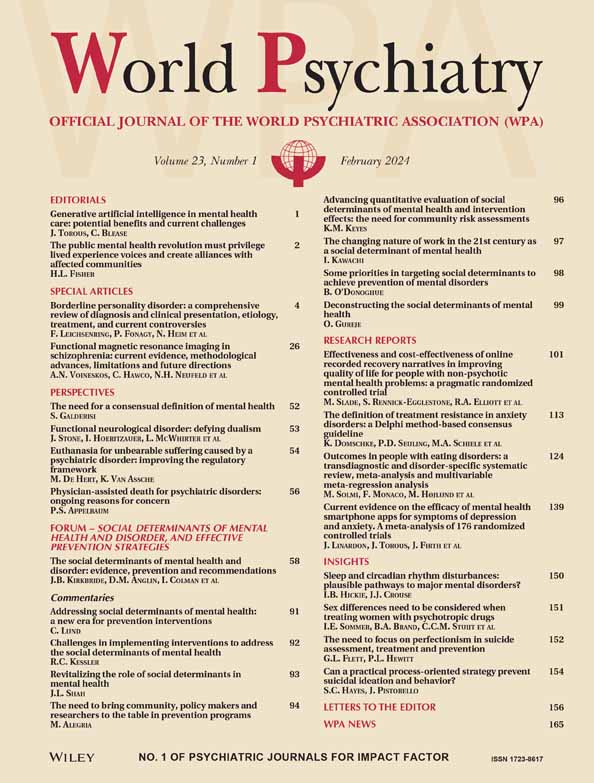Antipsychotic augmentation vs. monotherapy in schizophrenia: systematic review, meta‐analysis and meta‐regression analysis
IF 65.8
1区 医学
Q1 PSYCHIATRY
引用次数: 158
Abstract
Antipsychotic polypharmacy in schizophrenia is much debated, since it is common and costly with unclear evidence for its efficacy and safety. We conducted a systematic literature search and a random effects meta‐analysis of randomized trials comparing augmentation with a second antipsychotic vs. continued antipsychotic monotherapy in schizophrenia. Co‐primary outcomes were total symptom reduction and study‐defined response. Antipsychotic augmentation was superior to monotherapy regarding total symptom reduction (16 studies, N=694, standardized mean difference, SMD=–0.53, 95% CI: −0.87 to −0.19, p=0.002). However, superiority was only apparent in open‐label and low‐quality trials (both p<0.001), but not in double‐blind and high‐quality ones (p=0.120 and 0.226, respectively). Study‐defined response was similar between antipsychotic augmentation and monotherapy (14 studies, N=938, risk ratio = 1.19, 95% CI: 0.99 to 1.42, p=0.061), being clearly non‐significant in double‐blind and high‐quality studies (both p=0.990). Findings were replicated in clozapine and non‐clozapine augmentation studies. No differences emerged regarding all‐cause/specific‐cause discontinuation, global clinical impression, as well as positive, general and depressive symptoms. Negative symptoms improved more with augmentation treatment (18 studies, N=931, SMD=–0.38, 95% CI: −0.63 to −0.13, p<0.003), but only in studies augmenting with aripiprazole (8 studies, N=532, SMD=–0.41, 95% CI: −0.79 to −0.03, p=0.036). Few adverse effect differences emerged: D2 antagonist augmentation was associated with less insomnia (p=0.028), but more prolactin elevation (p=0.015), while aripiprazole augmentation was associated with reduced prolactin levels (p<0.001) and body weight (p=0.030). These data suggest that the common practice of antipsychotic augmentation in schizophrenia lacks double‐blind/high‐quality evidence for efficacy, except for negative symptom reduction with aripiprazole augmentation.精神分裂症的抗精神病药物增强与单一治疗:系统评价、荟萃分析和荟萃回归分析
精神分裂症的多重抗精神病药物治疗存在很大争议,因为它很常见,而且费用高昂,而且其有效性和安全性的证据还不清楚。我们进行了系统的文献检索和随机效应荟萃分析,对精神分裂症患者进行了二次抗精神病药物增强治疗与持续抗精神病药物单药治疗的随机试验进行了比较。共同主要结局是总症状减轻和研究定义的缓解。抗精神病药物增强治疗在减轻总症状方面优于单一治疗(16项研究,N=694,标准化平均差异,SMD= -0.53, 95% CI: - 0.87至- 0.19,p=0.002)。然而,优势仅在开放标签和低质量试验中显现(p均<0.001),而在双盲和高质量试验中则不明显(p分别=0.120和0.226)。研究定义的疗效在抗精神病药物增强治疗和单药治疗之间相似(14项研究,N=938,风险比= 1.19,95% CI: 0.99至1.42,p=0.061),在双盲和高质量研究中明显不显著(p均=0.990)。研究结果在氯氮平和非氯氮平强化研究中得到了重复。在全因/特异因停药、总体临床印象以及阳性、一般和抑郁症状方面没有出现差异。阴性症状在强化治疗中得到更多改善(18项研究,N=931, SMD= -0.38, 95% CI: - 0.63至- 0.13,p<0.003),但仅在阿立哌唑强化治疗中得到改善(8项研究,N=532, SMD= -0.41, 95% CI: - 0.79至- 0.03,p=0.036)。不良反应差异不大:D2拮抗剂增加与失眠减少相关(p=0.028),但催乳素升高较多(p=0.015),而阿立哌唑增加与催乳素水平降低(p<0.001)和体重降低相关(p=0.030)。这些数据表明,除了阿立哌唑增强治疗能减轻阴性症状外,精神分裂症患者常用的抗精神病药物增强治疗缺乏双盲/高质量的疗效证据。
本文章由计算机程序翻译,如有差异,请以英文原文为准。
求助全文
约1分钟内获得全文
求助全文
来源期刊

World Psychiatry
医学-精神病学
自引率
7.40%
发文量
124
期刊介绍:
World Psychiatry is the official journal of the World Psychiatric Association. It is published in three issues per year.
The journal is sent free of charge to psychiatrists whose names and addresses are provided by WPA member societies and sections.
World Psychiatry is also freely accessible on Wiley Online Library and PubMed Central.
The main aim of World Psychiatry is to disseminate information on significant clinical, service, and research developments in the mental health field.
The journal aims to use a language that can be understood by the majority of mental health professionals worldwide.
 求助内容:
求助内容: 应助结果提醒方式:
应助结果提醒方式:


